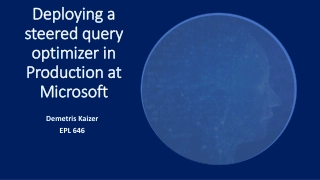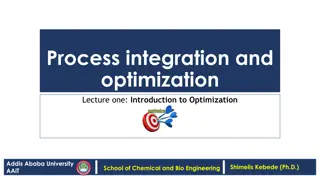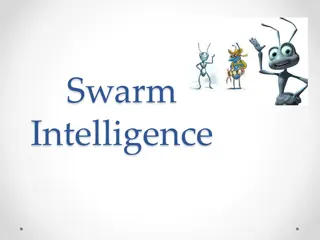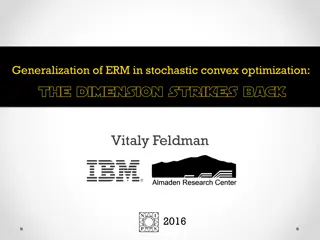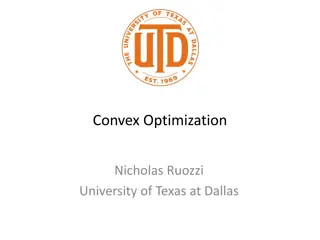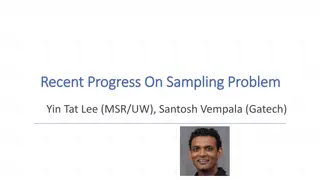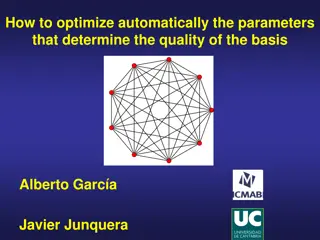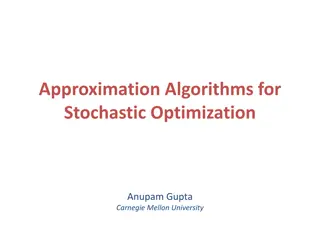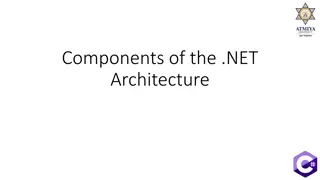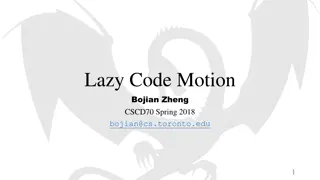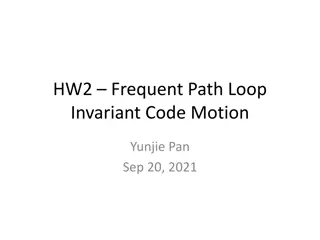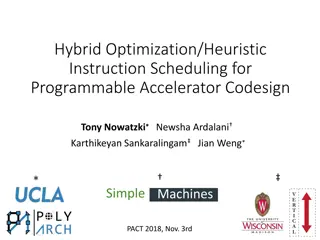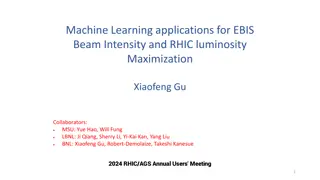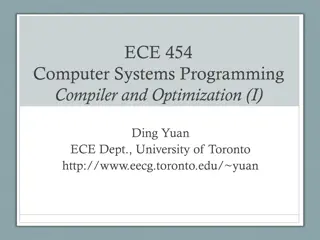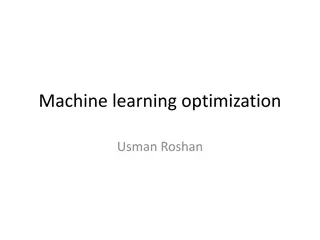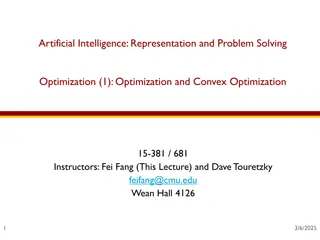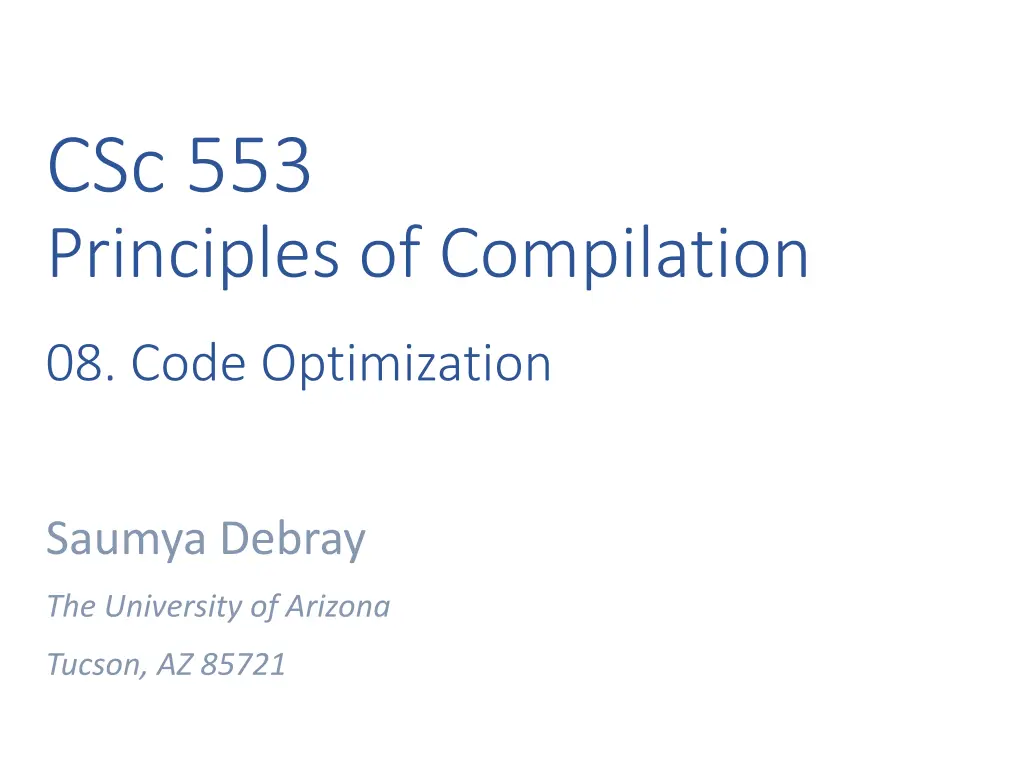
Code Optimization Techniques
Explore the principles and methods of code optimization to enhance program performance. Learn about common subexpression elimination, loop transformations, and function-preserving optimizations. Understand the importance of safety and criteria for effective code optimization efforts. Dive into the world of program analysis and optimization with a focus on achieving measurable performance improvements while preserving program semantics.
Uploaded on | 0 Views
Download Presentation

Please find below an Image/Link to download the presentation.
The content on the website is provided AS IS for your information and personal use only. It may not be sold, licensed, or shared on other websites without obtaining consent from the author. If you encounter any issues during the download, it is possible that the publisher has removed the file from their server.
You are allowed to download the files provided on this website for personal or commercial use, subject to the condition that they are used lawfully. All files are the property of their respective owners.
The content on the website is provided AS IS for your information and personal use only. It may not be sold, licensed, or shared on other websites without obtaining consent from the author.
E N D
Presentation Transcript
CSc 553 Principles of Compilation 08. Code Optimization Saumya Debray The University of Arizona Tucson, AZ 85721
Code Optimization Aim: to improve program performance. optimization a misnomer: attaining optimal performance is impossible or impractical in general. Criteria: must be safe, i.e., preserve program semantics; on average, should improve performance measurably; o occasionally, a few programs may suffer performance degradation. the transformation should be worth the effort. Program Analysis and Optimization 2
Code Optimizer Organization Program Analysis and Optimization 3
Code Optimization: Basic Requirements Fundamental Requirement: safety. The observable behavior of the program (i.e., the output computed for any given input) must not change. Program analyses must be correspondingly safe. most runtime properties of a program are statically undecidable. static program analyses are (necessarily) imprecise. any imprecision must be in the direction of safety. Program Analysis and Optimization 4
Some Important Optimizations Loop transformations: reduces the number and/or cost of instructions within loops. Examples: o invariant code motion out of loops o induction variable elimination o loop unrolling Function-preserving transformations: reduces unnecessary computations, but not aimed specifically at loops. Examples: o common subexpression elimination o copy propagation o dead/unreachable code elimination o function inlining Program Analysis and Optimization 5
Optimization 1. Common Subexpression Elimination Goal: to detect and eliminate repeated computations of the same expression. Can be done at two different levels: Local CSE: o scope limited to a single basic block Global CSE: o applies across basic block boundaries o uses available expressions analysis. Program Analysis and Optimization 6
Global Common Subexpression Elimination Uses available expression information to identify common subexpressions Program Analysis and Optimization 7
Global CSE: Algorithm Compute available expressions for each block. Process each block B as follows: for each instruction I x = y z where y z is available immediately before I, do: 1. find the evaluations of y z that reach I: traverse B, and then the control flow edges, backwards, not going beyond any block that evaluates y z . 2. create a new variable u. 3. replace each instruction w = y z found in (1) by the following: u = y z w = u 4. replace instruction Iby x = u . Program Analysis and Optimization 8
Comments on Global CSE For lightweight expressions (e.g., *p ), CSE may be profitable only if the expression can be kept in a register. But this means that the register is unavailable for other uses. The algorithm given will miss the fact that t1*4 and t3*4 have the same value in t1 = x+y t2 = t1*4 t3 = x+y t4 = t3*4 This can be handled by iterative applications of global CSE + copy propagation. Program Analysis and Optimization 9
Optimization 2. Copy Propagation Copy instructions: of the form x = y arise from normal code generation (e.g., assignment of an expression), and also as a result of optimizations such as global CSE. Goal of Copy Propagation: Given a copy instruction x = y , attempt to replace subsequent uses of x by y. Program Analysis and Optimization 10
Copy Propagation: Example Program Analysis and Optimization 11
When is Copy Propagation Legal? OK: Not OK: Not OK: Program Analysis and Optimization 12
Legality Conditions for Copy Propagation A copy instruction s x = y can be propagated to a use u of x if: 1. s is the only definition of x reaching u; and 2. there is no path from s to u that redefines y and which does not then go through s again. Condition 1 can be checked using u-d chains. This is is generalization of reaching definitions that associates, with each use u of a variable x, all the definitions of x that reach u. Program Analysis and Optimization 13
Effects of Copy Propagation When a copy instruction s x = y is propagated to uses of x, the no. of uses of s decreases. If the number of uses of s goes to 0, then s becomes dead code, and can be eliminated. Program Analysis and Optimization 14
Optimization 3. Dead Code Elimination Definition: An instruction is dead if the value it computes can be guaranteed to not be used. I x = e is dead if x is dead at the point immediately after I, and the evaluation of e has no side effects on any variable that is live at the point after I. Dead code can arise due to other optimizations, e.g., constant propagation, copy propagation. Program Analysis and Optimization 15
Dead Code and its Elimination Eliminating a dead instruction can cause other instructions to become dead: (1) x = y + z v dead; w, x live (2) w = 4 * x v, x dead; w live (3) v = w + 1 v, w, x dead; instr. (3) dead Goal: Identify instructions that are (a) dead, or (b) will become dead once other dead instructions are eliminated. Program Analysis and Optimization 16
Dead Code Elimination: Algorithm 1. mark all instructions live ; 2. repeat: for each instruction I x = : if the value of x defined by I (i) is not visible outside the current function; and (ii) is not used by any instr. J (J I) marked live : mark I dead ; until no more instructions can be marked. Program Analysis and Optimization 17

